Japanese castles in Korea
Japanese Castles in Korea (Korean: 왜성; Hanja: 倭城; RR: Waeseong; Japanese: 倭城, romanized: Wajō, Wesōn) are Japanese castles built along the southern shores of Korea during Japanese invasions of Korea between 1592 and 1598 by the Japanese military.[1]
Japanese castles in Korea can be classified into two categories: castles that were built to secure supply lines for Japanese forces moving throughout Korea, and castles that were built mainly along the southern coast of Korea to act as seats of governing power.[2]
The first category of castles were built between Busan and Seoul at intervals roughly equal to the distance an army could march in one day. The castle network was later expanded northward to Uiju. These castles were established by either reinforcing existing settlements, or were built anew if no suitable settlements existed in the area where a castle was needed.[3] Although the locations are currently unknown, Japanese castles are also believed to have been built between Kilju and Anbyŏn in the historical Hamgyong Province.[4]
The second category of castles built along the southern coast of Korea were located in Busan, Ulsan, South Gyeongsang Province, Suncheon, South Jeolla Province).[5]
Japanese castles are thought to have been built not only on the southern coast of the Korean[6] Peninsula but also in the inland areas[7], but the reality is unknown. Thirty-two areas on the southern coast have already been investigated.[8]
Other
In 2019, a map of Japanese castle locations, called "Joseong Japanese Illustration," was discovered and became a topic of conversation.
List of Japanese castles in Korea
Shows a list of Japanese castles (approximately from north to north).
Japanese Invasion of Korea (1592 ~ 1598)
- In April 1592 shortly after the start of the Japanese invasions of Korea, the Japanese army that landed in Busan built a castle there to establish a supply base. In November of the same year, the Konishi army that occupied Pyongyang built the castle there, and Ukiota built the castle in Namsan. In January of the following year, the Japanese army built about 20 Waseongs on the coast of South Gyeongsang Province today from May 1593.
| Number | Photo | Revised Romanization | Hangul | Hanja | Birth | Congregation | defense | Location | Comments |
|---|---|---|---|---|---|---|---|---|---|
| 1 | Nulcha Waeseong | 눌차왜성 | 訥次倭城 | 1592s | 6th Army (毛利 輝元) commander of the 6th army (小早川隆景) |
commander of the 6th army (小早川隆景) 6th Army (毛利秀包) (立花 宗茂) (島津家久) (日本軍) |
84-7 Sanj-7 Nulcha-dong Gangseo District, Busan Busan Republic of Korea (Korea: Busan Gangseo District, Busan Nulcha-dong 84-7 Sanj-7) |
눌차왜성 (2008년 발굴, 한국문물연구원), 가덕도왜성[11] | |
| 2 | Gadeokdo Waeseong Jiseong | 가덕도 왜성지성 | 加德島倭城支城 | 1593s | Fourth Army (高橋 元種) 6th Army (筑紫廣門) (立花 宗茂) (毛利秀包) (高橋統増) |
196 Seongbuk-dong Mountain Gangseo District, Busan Busan Republic of Korea (Korea: Busan Gangseo District, Busan Mountain Seongbuk-dong 196) |
성북왜성 | ||
| 3 | Gadeokdo Seongbuk Waeseong | 가덕도 성북왜성 | 加德島城北倭城 | 1593s | commander of the 6th army (小早川隆景) |
the general commander of the left army general (小早川秀包) Taziba Touko (立花統虎) |
San 43, 53, and 52 in Seongbuk-dong 52rd Mountain, 53rd Mountain Gangseo District, Busan Busan Republic of Korea (Korea: Busan Gangseo District, Busan 52rd Mountain, 53rd Mountain Seongbuk-dong San 43, 53, and 52 in) |
See also Siege of Busan | |
| 4 |  |
Waeseong in Jukseong-ri, Gijang | 기장 죽성리왜성 | 機張 竹城里倭城(Japanese: 機張城) | 1593s | commander of the third army (黒田 長政) |
Second Army Commander (加藤 清正) |
52-1 Jukseong-ri a member of Mount Gijang-eup Gijang-gun Busan Republic of Korea (Korea: Busan Gijang-gun Gijang-eup a member of Mount Jukseong-ri 52-1) |
죽성리왜성, 豆毛浦倭城 (2002년 발굴) 부산광역시 기념물 제48호, 기장성-일본[12] |
| 5 | 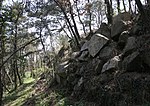 |
Gimhae Jukdo Waeseong | 김해 죽도왜성 | 金海 竹島倭城 | 1593s | Second Army (鍋島 直茂) (鍋島勝茂) |
Second Army (鍋島 直茂) |
787 Jukrim-dong a member of Gangseo District, Busan Busan Republic of Korea (Korea: Busan Gangseo District, Busan a member of Jukrim-dong 787) |
가락성, 죽도성, 김해왜성(2004년 발굴) 부산광역시 기념물 제47호[13] |
| 6 |  |
Gupo Waeseong | 구포왜성 | 龜浦倭城(Japanese: カードカイ城 카도카이쇼) | 1593s | The first commander of the 6th army (小早川隆景) 6th Army (筑紫廣門) (立花 宗茂) (立花 直次) (毛利秀包) the commander of the U. or commander-in-chief (毛利 秀元) |
Secondary commander of the third army (黒田 長政) |
93 Deokcheon 1-dong Mountain Buk-gu (Busan) Busan Republic of Korea (Korea: Busan Buk-gu (Busan) Mountain Deokcheon 1-dong 93) |
감동포성, 의성 (2002, 2004년 발굴) 부산광역시 기념물 6호 카도카이성-일본 九法谷의 陳. 죽도왜성의 지성[14] |
| 7 | Gimhae Nongso Waeseong Site | 김해 농소왜성지(농소왜성)[15] | 金海 農所倭城址 | 1593s | Second Army (鍋島 直茂) |
San 86-5 in Cheongok-ri Juchon-myeon Gimhae and Nongsori Mountain 22-5 in Juchon-myeon Gimhae Gyeongsangnam-do Republic of Korea (Korea: Gyeongsangnam-do Gimhae Juchon-myeon Cheongok-ri in San 86-5 and Gimhae Juchon-myeon in Mountain 22-5 Nongsori) |
신답지성 (2001년 발굴), 죽도왜성의 지성 2001년(경남문화재연구원)[16] | ||
| 8 | Masa Waeseong | 마사왜성[17] | 馬沙倭城 | 1593s | Second Army (鍋島 直茂) |
Geumgok-ri Mountains 1 Hanlim-myeon Gimhae and Mount Masari 205 Sanglim-myeon Gimhae Gyeongsangnam-do Republic of Korea (Korea: Gyeongsangnam-do Gimhae Sanglim-myeon Mount Masari 205 and Gimhae Hanlim-myeon Geumgok-ri Mountains 1) |
土城, 죽도왜성의 지성[18] | ||
| 9 | Dadaepo Seong Site | 다대포성지 | 多大浦城址 | 1593s | First Army Commander (小西 行長) (宗 義智) |
11 (Dadae-dong) Dadae-ro 529 Saha District Busan Republic of Korea (Korea: Busan Saha District Dadae-ro 529 - 11 (Dadae-dong)) |
See also Siege of Busan | ||
| 10 | Dongnae Waeseong | 동래왜성(동래읍성지) | 東萊倭城 | 1593s | (吉川 広家) |
First Army Commander (小西 行長) |
Chilsan-dong Mountain2 / Allak-dong 20 Dongnae-gu Busan Republic of Korea (Korea: Busan Dongnae-gu Chilsan-dong Mountain2 | Allak-dong 20) |
『大東地志』 城池 甑山城 倭人所築. (증산성을 왜인이 쌓았다.) | |
| 11 | Dongsamdong Waeseong | 동삼동왜성 | 東三洞倭城 | 1593s | 6th Army (毛利 輝元) |
210 Dongsam 1-dong Yeongdo District Busan Republic of Korea (Korea: Busan Yeongdo District Dongsam 1-dong 210) |
동삼동왜성(東三洞倭城), 추목도성(椎木島城), 절영도 추목도단성 | ||
| 12 | 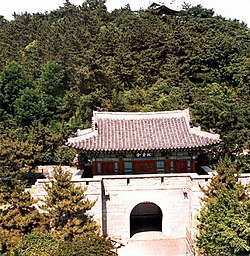 |
Busanjinseong | 부산진성 | 釜山鎭城(Japanese: 丸山城, まるやまじょう) | 1593s (1598s) | 6th Army (毛利 輝元) the commander of the U. or commander-in-chief (毛利 秀元) a command post (shrinkage and augmentation) |
6th Army (毛利 輝元) |
(Beomil-dong) Magnetic furnace 99 Dong District, Busan Busan Republic of Korea (Korea: Busan Dong District, Busan Magnetic furnace 99 (Beomil-dong)) |
소서성, 환산성, 부산왜성의 지성[19] |
| 13 |  |
Seosaengpo Waeseong | 서생포왜성 | 西生浦倭城 | 1593s | Second Army Commander (加藤 清正) |
commander of the third army (黒田 長政) |
711 member of Seosaeng-ri, Seosaeng-myeon Ulju-gun Ulsan Republic of Korea (Korea: Ulsan Ulju-gun Seosaeng-myeon member of Seosaeng-ri, 711) |
烽火城(2012년 발굴)[20] |
| 14 | Imrangpo Waeseong | 임랑포왜성 | 林浪浦倭城(Japanese: せいぐわん城) | 1593s | commander of the 4th army (毛利 勝信) Fourth Army (島津 豊久) (伊東 祐兵) (高橋 元種) (秋月 種長) |
commander of the 4th army (毛利 勝信) Fourth Army (島津 豊久) (伊東 祐兵) (高橋 元種) (秋月 種長) |
51 imrang-ri Mountain Jangan-eup Gijang-gun Busan Republic of Korea (Korea: Busan Gijang-gun Jangan-eup Mountain imrang-ri 51) |
발굴조사 : 2001년(중앙문화재연구원) 세이관성-일본[21] | |
| 15 | Yeongdeungpo Waeseong | 영등포왜성 | 永登浦倭城 | 1592s | Fourth Army (島津 義弘) |
6-17 Guyeong-ri Mountain Jangmok-myeon Geoje Gyeongsangnam-do Republic of Korea (Korea: Gyeongsangnam-do Geoje Jangmok-myeon Mountain Guyeong-ri 6-17) |
唐島城, 영등왜성[22] | ||
| 16 | Songjinpo Waeseong | 송진포왜성 | 松眞浦倭城 | 1593s | Commander of the Fifth Army (福島 正則) Fifth Army (戶田勝隆) (長曾我部元親) |
36-3 Songjin-Foree Mountains Jangmok-myeon Geoje Gyeongsangnam-do Republic of Korea (Korea: Gyeongsangnam-do Geoje Jangmok-myeon Mountains Songjin-Foree 36-3) |
시루성(甑城)[23] | ||
| 17 |  |
Geoje Jangmunpo Waeseong | 거제 장문포 왜성 | 巨濟 長門逋 倭城 | 1594s 11. | Commander of the Fifth Army (福島 正則) Fifth Army (蜂須賀 家政) (生駒 親正) (戶田勝隆) |
Fifth Army (長曾我部元親) (生駒 親正) |
130-43 Jangmok-ri Jangmok-myeon Geoje Gyeongsangnam-do Republic of Korea (Korea: Gyeongsangnam-do Geoje Jangmok-myeon Jangmok-ri 130-43) |
장목왜성 경상남도 문화재자료 제273호[24] |
| 18 |  |
Geoje Jisepo Jinseong | 거제 지세포진성 | 巨濟 知世浦鎭城 | 1593s | Second Army Commander (加藤 清正) |
235-4 G-celli Ilun-myeon Geoje Gyeongsangnam-do Republic of Korea (Korea: Gyeongsangnam-do Geoje Ilun-myeon G-celli 235-4) |
See also Siege of Geoje 지세포왜성 | |
| 19 | Jinhae Jamasan Seong | 진해 자마산성 | 鎭海 子馬山城 | 1593s | First Army (宗 義智) |
15 Mountain Seongnae-dong Jinhae-gu Changwon Gyeongsangnam-do Republic of Korea (Korea: Gyeongsangnam-do Changwon Jinhae-gu Seongnae-dong Mountain 15) |
웅천왜성의 지성 소산성, 동지성, 감포산성, 자마산성 | ||
| 20 | Jinhae Myeongdong Waeseong | 진해 명동왜성 | 鎭海 明洞倭城 | 1593s | First Army (松浦鎭信) (宗 義智) |
1-Mountain Myeong-dong Jinhae-gu Changwon Gyeongsangnam-do Republic of Korea (Korea: Gyeongsangnam-do Changwon Jinhae-gu Myeong-dong Mountain-1) |
웅천왜성의 지성, 소산성(小山城) | ||
| 21 | 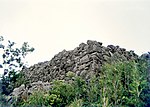 |
Changwon Jinhae Angol Waeseong | 창원 진해 안골왜성(웅천 안골왜성) | 昌原 鎭海 安骨倭城 | 1593s | a water soldier (脇坂 安治) (加藤 嘉明) commander of the water army (九鬼 嘉隆) |
et al. Angol-dong Mount Twenty-seven Jinhae-gu Changwon Gyeongsangnam-do Republic of Korea (Korea: Gyeongsangnam-do Changwon Jinhae-gu Twenty-seven Mount Angol-dong et al.) |
경상남도 문화재자료 제275호 왜수군 제1기지 (2009년 발굴 동양문물연구원) | |
| 22 |  |
Changwon Jinhae Ungcheon Waeseong | 창원 진해 웅천왜성 | 昌原 鎭海 熊川倭城 | 1593s | First Army Commander First Army → (宗 義智) |
211-1 Nammun-dong Mountain Jinhae-gu Changwon Gyeongsangnam-do Republic of Korea (Korea: Gyeongsangnam-do Changwon Jinhae-gu Nammun-dong Mountain 211-1) |
남산왜성. 경상남도 문화재자료 제79호 일본 제2수군기지 | |
Japanese Invasion of Korea (1597 ~ 1598)
- The Japanese army, which had been re-invading after the peace negotiations between the Japanese and Keicho broke down, took over the castle that had been built up until now, and the Japanese navy took over the Kumakawa castle and used it as a base. At that time, the Japanese military secured the occupied land and repaired the traditional coastal area to connect with the Japanese mainland, while the line of battle expanded to Ulsan in the east and Suncheon in the west, and the castle was newly built in this area.
- After the collapse of the negotiations on strengthening the Japanese Invasion of Korea in 1592, the Japanese army occupied the Japanese fortress again, and the Japanese navy occupied Ungcheon Japanese Fortress as its base. At that time, the Japanese army secured the occupied area and repaired the existing Japanese fortress along the coast to connect with the Japanese mainland, and the Japanese fortress was newly built in this area as the front line expanded to Ulsan on the east and Suncheon on the west.
| Number | Photo | Revised Romanization | Hangul | Hanja | Birth | Congregation | defense | Location | medical history | Comments |
|---|---|---|---|---|---|---|---|---|---|---|
| 23 | Goseong Eupseong | 고성읍성 | 固城邑城 | 1597s | (吉川 広家) (桂元網) |
Second Army (鍋島 直茂) |
Seongnae-ri, Seohan-ri, and Sumam-ri Goseong-eup Goseong County, South Gyeongsang Gyeongsangnam-do Republic of Korea (Korea: Gyeongsangnam-do Goseong County, South Gyeongsang Goseong-eup Seongnae-ri, Seohan-ri, and Sumam-ri) |
a military force : 7,000 Personnel | 수남리왜성, 경상남도 문화재자료 제89호[26] | |
| First Army (宗 義智) Karashima Setoguchi[28] (ガラ島瀬戸口) |
Yanagawa Shigenobu(柳川調信) | (Korea: Gyeongsangnam-do Geoje Sadeung-myeon Deokho-ri 267) |
왜성동왜성, 광리왜성 토성(土城)[29] | |||||||
| 25 | Namhae Seonso Castle | 남해 선소왜성 | 南海 船所倭城 | 1597s | a water soldier (脇坂 安治) First Army (宗 義智) |
First Army (宗 義智) |
163-1 Seonso-ri Namhae-eup Namhae County Gyeongsangnam-do Republic of Korea (Korea: Gyeongsangnam-do Namhae County Namhae-eup Seonso-ri 163-1) |
a military force : 1,000 Personnel | 경남발전연구원 역사문화센터, 2004, 『문화유적분포지도-남해군-』.[30] | |
| 26 |  |
Busan Japan Seong | 부산일본성 | 釜山日本城 | 1598s | 6th Army (毛利 輝元) First Army Commander (小西 行長) |
the general commander of the left army general (小早川秀包) |
Beomil-dong Dong District, Busan Busan Republic of Korea (Korea: Busan Dong District, Busan Beomil-dong) |
『增補文獻備考』21) 釜山浦城 甑山城 備局謄錄 並有倭人. (부산포성, 증산성은 비국등록에는 모두 왜인이 있다고 기록하였다.)[31] | |
| 27 | 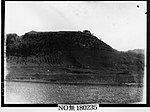 |
Masan Japan Seong | 마산일본성 | 馬山日本城 | 1597s | Invitation Sano Ryohaku[32] (佐野了伯) Second Army (鍋島 直茂) (鍋島勝茂) |
Sanho-dong Masanhappo-gu Changwon Gyeongsangnam-do Republic of Korea (Korea: Gyeongsangnam-do Changwon Masanhappo-gu Sanho-dong) |
a military force : 12,000 Personnel | 창원왜성, 용마성 『大東地志』 城池 江馬山城 倭人所築. (강마산성을 왜인이 쌓았다.) 『增補文獻備考』 舊江馬山城 備局謄錄 並有倭城. (구 강마산성(용마산성, 또는 마산왜성)은 비국등록에 왜성이 있다고 기록하였다.) | |
| 28 | 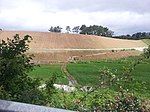 |
Waeseong in Seonjin-ri, Sacheon | 사천선전리성 | 泗川船津里城 | 1597s | commander of the 4th army (毛利 勝信) |
Fourth Army (left-wing army) (島津 義弘) |
770 Yonghyeon-myeon Advanced-ri, etc. Sacheon Gyeongsangnam-do Republic of Korea (Korea: Gyeongsangnam-do Sacheon Advanced-ri, etc. Yonghyeon-myeon 770) |
a military force : 10,000 Personnel | 선진리왜성(2005년 발굴) 경상남도 문화재자료 제274호[33] See also Battle of Sacheon (1598) |
| 29 | 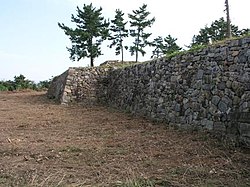 |
Suncheon Castle | 순천왜성 | 順天倭城 | 1597s | First Army Commander (left-wing army) (小西 行長) general commander and commander of the 7th army (Left Commander) (宇喜多 秀家) a water soldier (騰堂 高虎) |
First Army Commander (left-wing army) (小西 行長) a water soldier (騰堂 高虎) |
1st Mountain, Sinseong-ri, Haeryong-myeon Suncheon Jeolla Province Republic of Korea (Korea: Jeolla Province Suncheon Haeryong-myeon Mountain, Sinseong-ri, 1st) |
a military force : 13,700 Personnel | 왜교성, 예교성 (2001, 2002, 2004년 발굴), 전라남도 지방기념물 제171호 (1999년 2월 26일 지정)[34] See also Siege of Suncheon All that remains of the castle today is the stone base. |
| 30 | 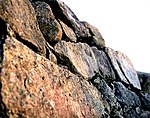 |
Waeseong in Jeungsan-ri, Yangsan | 양산 증산리 왜성 | 勿禁 甑山里 倭城 | 1597s | commander of the third army (Woo Gun) (黒田 長政) Daimyo (伊達 政宗) |
commander of the third army (Woo Gun) (黒田 長政) |
38-1 Mulgeum-ri, Mulgeum-eup Yangsan Gyeongsangnam-do Republic of Korea (Korea: Gyeongsangnam-do Yangsan Mulgeum-eup Mulgeum-ri, 38-1) |
증산리왜성(甑山里倭城) 경상남도 문화재자료 제276호[35] | |
| 31 | Ulsan Castle | 울산왜성 | 蔚山倭城 | 1597s | Second Army Commander (Woo Gun) (加藤 清正) Eighth Army (command's service) (淺野 幸長) |
Second Army Commander (Woo Gun) (加藤 清正) |
(Ulsan) Hakseong-dong Hakseong Park 3-gil, Jung District, Ulsan Ulsan Republic of Korea (Korea: Ulsan Jung District, Ulsan Hakseong Park 3-gil, Hakseong-dong (Ulsan)) |
a military force : 10,000 Personnel | 학성, 도산성 (1985년 발굴) 울산광역시 문화재자료 제7호(1997년 10월 30일 지정)[36] |
Command Post
- The Japanese army, which landed in Busan shortly after the start of the Japanese invasion of Korea in April 1592, built the fortress to establish a supply base. In November of the same year, Konishi County, which occupied Pyongyang, built a dwarf planet in Pyongyang, while Ukida built a dwarf planet in Namsan, just south of Hanseong. However, the Japanese army, which began to be chased by the Cho-Myong coalition forces in January of the following year, built some 20 dwarfs along the coast of what is now South Gyeongsang Province from May 1593.
- The Japanese army, which had invaded again after the collapse of negotiations to strengthen the Japanese invasion of Korea, occupied the previously-built dwarf planet and made the Japanese army its base by occupying the Ungcheon dwarf. At that time, the Japanese military secured the occupied area and repaired the previously built coastal dwarfs for connection with the mainland Japan, while the front was extended to Ulsan on the east and Suncheon on the west.
| Past | one's family | Name | Photo | inauguration | Death | History |
|---|---|---|---|---|---|---|
| Tae-hyup, instead of Tae-jeong (a shrine to various gods) |
  |
Toyotomi Hideyoshi (豐臣 秀吉) |
 |
1555s | 1600s lunar calendar (October 1) | Sengoku Daimyo, the very person, National Three Young Girls (전국 3영걸), Chikuzenokami, the fifth rank of the species (종오위하), Left-handed chief, Occupation status (종사위하) True (참의) a third-rate class (종삼위) Dainagon(大納言), a regular second (정이위) the Lord Keeper of the Privy Seal(內大臣), No. 1 in species (종일위) Gwanbaek (관백 - 関白), instead of Tae-jeong (태정대신), certificate a regular first (정일위) |
Congregation and defense Commander
| Past | one's family | Name | Photo | inauguration | Death | History |
|---|---|---|---|---|---|---|
| a command (post) |  |
Asano Nagamasa (浅野 長政) |
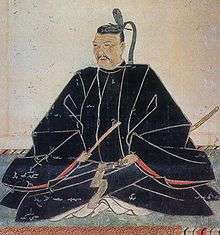 |
1547s | 1611s May 29 | the fifth rank of the species (종오위하), Danjo Shohitsu(弾正少弼) |
| the first generation (First Army Commander) (left-wing army) |
 |
Konishi Yukinaga (小西 行長) |
 |
1555s | 1600s lunar calendar(October 1) | Sengoku Armour (센고쿠 무장), Father-in-law (장인), Girisitan (기리시탄), general of the army (원수), Ceremony (세레머니) |
| First Army ‘1st platoon‘ |  |
Sō Yoshitoshi (宗 義智) |
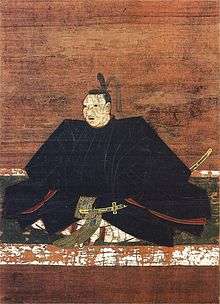 |
1568s | 1615s January 31 | Sengoku Armour (센고쿠 무장), Damyo Shrine (다이묘), general of the army (원수) |
| First Army ‘2nd platoon‘ |  |
Matsura Shigenobu (松浦鎭信) |
.jpg) |
1549s | 1614s July 3 | Damyo Shrine (다이묘), Occupation status (종사위하) |
| the second generation (Second Army Commander) (Woo Gun) |
.svg.png) |
Katō Kiyomasa (加藤 清正) |
 |
1562s July 25 | 1611s August 2 | Sengoku Armour (센고쿠 무장), Damyo Shrine (다이묘), general of the army (원수) |
| Second Army | 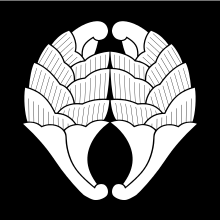 |
Nabeshima Naoshige (鍋島 直茂) |
_(detail).jpg) |
1538s April 12 | 1618s July 24 | Sengoku Armour (센고쿠 무장), a Japanese general (일본 장수), general of the army (원수) |
| Second Army under the banner Armour |  |
Nabeshima Katsushige (鍋島勝茂) |
 |
1580s December 4 | 1657s May 7 | Sengoku Armour (센고쿠 무장), Damyo Shrine (다이묘) |
| the third generation (Third Army Commander) (Woo Gun) |
 |
Kuroda Nagamasa (黒田 長政) |
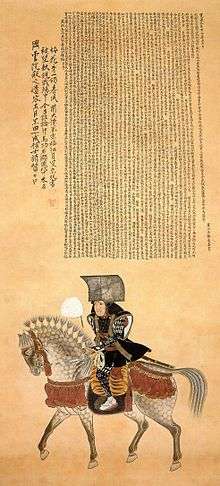 |
1568s December 21 | 1623s August 4 | Sengoku Armour (센고쿠 무장), Damyo Shrine (다이묘), general of the army (원수) |
| the fourth generation (commander of the 4th army) |  |
Mōri Yoshinari (毛利 勝信) |
an unknown birth | 1611s | Sengoku Armour (센고쿠 무장), Damyo Shrine (다이묘), general of the army (원수) | |
| Fourth Army ‘1st platoon‘ (left-wing army) |  |
Shimazu Yoshihiro (島津 義弘) |
 |
1535s lunar calendar (July 23) | 1619s lunar calendar (July 21) | Sengoku Armour (센고쿠 무장), Shugo Daimyo (슈고 다이묘), a member of the Japanese military (일본군 소속장), general of the army (원수) |
| Fourth Army ‘2nd platoon‘ |  |
Takahashi Mototane (高橋 元種) |
1571s | 1614s November 10 | Sengoku Armour (센고쿠 무장), Sengoku Daimyo (센고쿠 다이묘) | |
| Fourth Army ‘3rd platoon‘ |  |
Akizuki Tanenaga (秋月 種長) |
1500s the middle | 1600s Early | Armour, Damyo Shrine (다이묘) | |
| Fourth Army ‘4th platoon‘ |  |
Itō Suketaka (伊東 祐兵) |
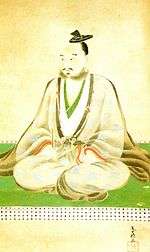 |
1559s February 22 | 1600s November 16 | Sengoku Armour (센고쿠 무장), Damyo Shrine (다이묘) |
| Fourth Army ‘5th platoon‘ | .svg.png) |
Shimazu Toyohisa (島津 豊久) |
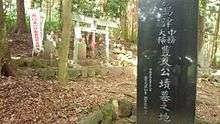 |
1570s | 1600s October 21 | Sengoku Armour (센고쿠 무장), Damyo Shrine (다이묘), an official landlord (관위부 지주), Nakatsuka-Sanotaihu(中務大輔) |
| the fifth (Commander of the Fifth Army) |  |
Fukushima Masanori (福島 正則) |
1561s | 1624s August 26 (lunar calendar Seven 13) | Damyo Shrine (다이묘), a Japanese general (일본 장수), general of the army (원수) | |
| Fifth Army ‘1st platoon‘ | .jpg) |
Toda Katsutaka (戸田勝隆) |
an unknown birth | 1594s December 4 | Sengoku Armour (센고쿠 무장), Damyo Shrine (다이묘) | |
| Fifth Army ‘2nd platoon‘ |  |
Chōsokabe Motochika (長宗我部 元親) |
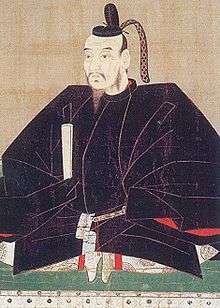 |
1539s | 1599s May 19 | Sengoku Daimyo (센고쿠 다이묘) |
| Fifth Army ‘3rd platoon‘ | 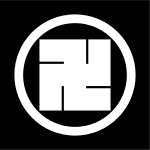 |
Hachisuka Iemasa (蜂須賀 家政) |
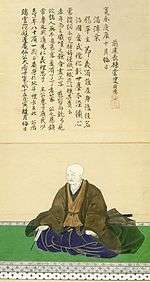 |
1558s | 1639s February 2 | Damyo Shrine (다이묘) |
| Fifth Army ‘4rd platoon‘ (a command post) |
.svg.png) |
Ikoma Chikamasa (生駒 親正) |
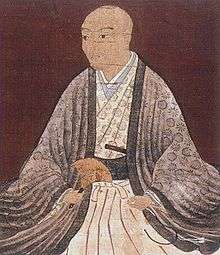 |
1555s | 1600s lunar calendar (October 1) | Sengoku Armour (센고쿠 무장), Damyo Shrine (다이묘), a lieutenant in command (지휘부급 중로) |
| the sixth generation (commander of the 6th army) (a general ledger - general commander) |
 |
Kobayakawa Takakage (小早川隆景) |
.jpg) |
1533s | 1597s July 26 | a general ledger (총대장), Sengoku Armour (센고쿠 무장), Damyo Shrine (다이묘), general of the army (원수) |
| The 6th Daimyo (Leader of the Left Army) |  |
Kobayakawa Hideaki (小早川秀秋) |
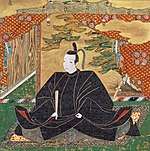 |
1582s | 1602s | a third-rate class (종삼위), Gwonjungnapeon(権中納言), Chikuzen (지쿠젠) |
| 6th Army ‘1st platoon‘ |  |
Mōri Hidekane (毛利秀包) |
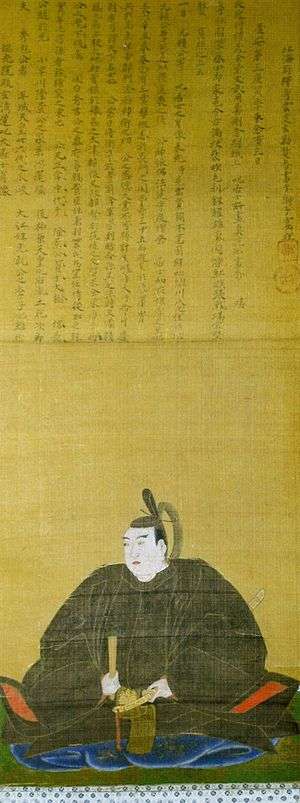 |
1567s | 1601s April 24 | Sengoku Armour (센고쿠 무장), Damyo Shrine (다이묘), general of the army (원수) |
| 6th Army ‘2nd platoon‘ |  |
Tachibana Muneshige (立花 宗茂) |
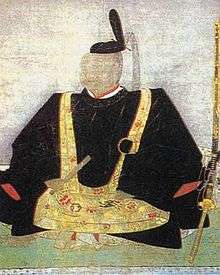 |
1567s September 20 | 1643s January 15 | Sengoku Armour (센고쿠 무장), Damyo Shrine (다이묘), posthumous promotion (추증), a third-rate class (종삼위), Saconoshogen (사콘노쇼겐), Shijong (시종), Hidanokami (히다노카미), general of the army (원수) |
| 6th Army ‘3rd platoon‘ |  |
Tachibana Naotsugu (立花 直次) |
1572s January 4 | 1617s August 20 | Sengoku Armour (센고쿠 무장), Damyo Shrine (다이묘), general of the army (원수) | |
| 6th Army ‘4rd platoon‘ |  |
Tsukushi Hirokado (筑紫 広門) |
1556s | 1623s May 22 | Sengoku Armour (센고쿠 무장), Damyo Shrine (다이묘) | |
| 6th Army ‘5th platoon‘ |  |
Mōri Terumoto (毛利 輝元) |
 |
1553s February 4 | 1625s June 2 | Sengoku Armour (센고쿠 무장), Damyo Shrine (다이묘), general captain of west (서군 총대장), general of the army (원수) |
| the seventh generation (commander of the 7th army) (a general ledger) (the commander of the left-in-chief) |
 |
Ukita Hideie (宇喜多 秀家) |
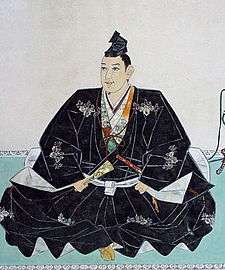 |
1572s | 1655s December 17 | a general ledger (총대장), Sengoku Armour (센고쿠 무장), Damyo Shrine (다이묘), a third-rate class (종삼위), a government-grade landlord (관위급 지주) an acid radical (산기), Sakon Aagon Altar(左近衛權中將), junagon(權中納言), general of the army (원수) |
| 8th platoon (Eighth Army) (a command post) |
 |
Asano Yoshinaga (淺野 幸長) |
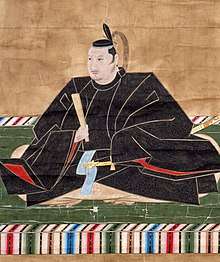 |
1576s | 1613s October 9 | Sengoku Armour (센고쿠 무장), Damyo Shrine (다이묘), command-level service (지휘부급 봉행) |
| the ninth (commander of the water army) |  |
Kuki Yoshitaka (九鬼 嘉隆) |
 |
1542s | 1600s November 17 | Sengoku Water Force Armored (센고쿠 수군 무장), Damyo Shrine (다이묘), general of the army (원수) |
| First Water Army |  |
Wakisaka Yasuharu (脇坂 安治) |
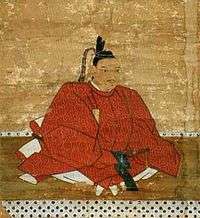 |
1554s | 1626s September 26 | Sengoku Armour (센고쿠 무장), Damyo Shrine (다이묘) |
| Second Water Army |  |
Katō Yoshiaki (加藤 嘉明) |
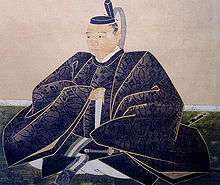 |
1563s | 1631s October 7 | Sengoku Armour (센고쿠 무장), Damyo Shrine (다이묘) |
| Third Water Army |  |
Tōdō Takatora (騰堂 高虎) |
 |
1556s February 16 | 1630s November 9 | Sengoku Armour (센고쿠 무장), Damyo Shrine (다이묘), general of the army (원수) |
| the tenth generation (the commander of the U. or commander-in-chief) |  |
Mōri Hidemoto (毛利 秀元) |
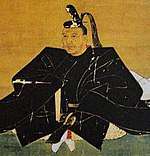 |
1579s November 25 (Rain Chuguk Sarukake Castle) |
1650s November 26 (Edo) | Sengoku Armour (센고쿠 무장), Damyo Shrine (다이묘), the third best (정삼위), an acid radical (산기), general of the army (원수) |
| the present head (representative) of the family |  |
Kikkawa Hiroie (吉川 広家) |
 |
1561s | 1625s | Sengoku Armour (센고쿠 무장), a working position (종사위), Minbu Shouyu(民部少輔), an official landlord (관위부 지주) |
| Damyo Shrine | 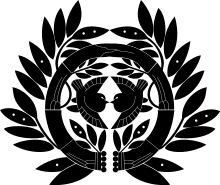 |
Date Masamune (伊達 政宗) |
 |
1567s September 5 | 1636s June 27 | the fifth rank of the species (종오위하), Sakyodaibu(左京大夫), an official landlord (관위부 지주), Echizen-Nokami (에치젠노카미), Occupation status (종사위하), Ugonogon Show(右近衛権少将), Mutsunokami (무쓰노카미), the third best (정삼위), an acid radical (산기), a third-rate class (종삼위), Gwonjungnapeon(権中納言), posthumous promotion (추증), second place of species (종이위), general of the army (원수) |
| Armored |  |
Shimazu Iehisa (島津家久) |
1547s | 1587s July 10 | Matashi-chiro(又七郎), Nakatsuka-sanotaihu(中務大輔) | |
| Hatamoto |  |
Kutsuki Mototsuna (朽木 元綱) |
1549s | 1632s October 12 | Sengoku Armour (센고쿠 무장), Damyo Shrine (다이묘), the fifth rank of the species (종오위하), cinnamonokami (시나노노카미), Kawachinokami (가와치노카미) | |
Gallery
 Japanese invasions of Korea (1592–1598) Ulsan Castle
Japanese invasions of Korea (1592–1598) Ulsan Castle Namhae Seonso Castle
Namhae Seonso Castle Ruins of Seosaengpo Castle
Ruins of Seosaengpo Castle- Ulsan Castle
 Busanjinseong
Busanjinseong
References
- japanese castles in korea 1592-98 2020년 8월 6일 확인
- ja:倭城
- 왜성
- KNN 뉴스 위기의 왜성, 몰아치는 개발 바람 2016년 6월 확인
- Untitled - 경남발전연구원 역사문화센터
- KNN 뉴스 위기의 왜성 5편 마구잡이 복원 석축 쌓았나 2016년 6월 확인
- KNN 뉴스 위기의 왜성. 붕괴 심각화 2016년 6월 확인
- 한국학도서관 한국학전자도서관 Korean Studies Library Korean Studies Electronics Library
- 지울 수 없는 역사의 흔적, 왜성 / YTN 사이언스 (시마즈 이에히사 등 일본군 500명 주둔) 2020년 7월 11일 확인
- 지울 수 없는 역사의 흔적, 왜성 / YTN 사이언스 (일본군 500명 주둔) 2020년 7월 11일 확인
- 山崎敏昭, 1998, 「加德城と安骨浦倭城の繩張り」 『倭城の硏究』2, 城郭談話會. 福島克彦, 1998, 「加德城と安骨浦城の構造」 『韓國 慶尙南道 倭城址の調査硏究』, 神戶大學文學部. 한국문물연구원, 2010, 『釜山 訥次洞 817-4番地遺蹟』. 釜山廣域市史編纂委員會, 1999, 『江西區誌』.
- 『增補文獻備考』 豆毛浦城 臨浪浦城 備局謄錄 並有倭城.(두모포성, 임랑포성은 비 국등록에 모두 왜성이라 기록하였다.)
- 『大東地志』 城池 竹島倭城 南十里 宣祖壬辰倭人所築 周五百八十척 外城周六百十五척.(남쪽으로 10리이고 선조 임진년(1592) 왜인이 쌓았다. 둘레는 580척 (약 176m)이고 외성의 둘레는 615척(약 186m)이다.) 『增補文獻備考』 竹島倭城 在南十里 壬辰倭賊石築 邑誌周五百八十척 外城周六百十五척.(죽도왜성은 남쪽으로 10리에 있고 임진년에 왜적이 돌로 쌓았다. 읍지에는 둘레 580척(약 176m), 외성 둘레 615척(약 186m)이라 기록하고 있다.
- 『大東地志』 城池 仇法谷城 狐浦城 二處倭所築.(구법곡성, 호포성 두 곳을 왜인이 쌓았다.) 『增補文獻備考』 仇法谷狐浦 備局謄錄 並有倭城.(구법곡성과 호포성은 비국등록에서 모두 왜성이라 기록하였다.)
- 농소왜성, 역사의 블랙박스, 왜성 재발견 - Google 도서 2019년 7월 8일 확인
- 高田徹, 1999, 「金海 竹島倭城の遺構と遺物-繩張り-」 『倭城の硏究』3, 城郭談話會. 高瀨哲郞, 1999, 「倭城蹟を訪ねて」 『硏究紀要』5, 佐賀縣立名護屋城博物館. 경남문화재연구원, 2004, 『김해 농소리유적』.
- 마사왜성, 역사의 블랙박스, 왜성 재발견 - Google 도서 2019년 7월 8일 확인
- 『大東地志』 城池 馬沙倭城 北四十里 土築 周七百餘척.(북쪽으로 40리에 있고 흙으 로 쌓았다. 둘레는 700여 척(약 212m)이다.) 『增補文獻備考』 馬沙倭城 在北四十里 土築 邑誌周七百餘척 高三척.(마사왜성은 북 쪽으로 40리에 있고 흙으로 쌓았으며 읍지에는 둘레 700여 척(약 212m), 높이 3 척(약 1m)으로 기록하고 있다.)
- 『增補文獻備考』 釜山浦城 甑山城 備局謄錄 並有倭人.(부산포성, 증산성은 비국 등록에는 모두 왜인이 있다고 기록하였다.) 『東萊府邑誌』25) 城池 釜山鎭城 在府南二十里 僉使所居也 壬辰亂倭人築之 城周千六 百八十九척 高十三척.(부산진성은 부의 남쪽 20리에 있고 첨사가 거주하였다. 임진 년에 왜인이 쌓았고 성의 둘레는 1689척(약 512m)이고 높이는 13척(약 4m)이다.)
- 『大東地志』 鎭堡 開雲浦鎭 南三十里 宣祖 二十五年 自蔚山移于釜山浦之倭人所築城 水軍萬戶一員.(남쪽으로 30리에 있고 선조 25년(1592)에 울산에서 부산포로 옮기고 왜인들이 쌓았다, 수군만호 1인을 두었다.)『大東地志』 鎭堡 西生浦鎭 南五十里 初置水軍萬戶 宣祖二十五年 移設于倭人所築之倭甑城 水軍同僉制使一人.(남쪽으로 50리에 있고 처음에는 수군만호를 두었다. 선조 25년(1592) 옮겨 왜인이 축성하고 왜증성이라 하였다. 수군첨제사33) 1인을 두었다.)『增補文獻備考』 外甑城 在西生鎭 亦倭賊所築.(외증성은 서생진에 있고 또한 왜적이 쌓았다.)『與地圖書』34) 鎭堡 西生浦鎭 在府南五十三里 水軍萬戶一人 壬辰倭寇築城留屯 丁酉撤還後倭人所築城.(서생포진은 부의 남쪽 53리에 있고 수군만호 1인이 주둔하였다. 임진년(1592)에 왜구가 축성하여 주둔하였다. 정유년(1597)에 다시 돌아온 왜인이 쌓았다.)『蔚山府邑誌』35) 鎭堡 西生浦鎭 在府南五十三里 水軍萬戶一人 壬辰倭寇築城留屯 丁酉撤還後倭人所築城.(서생포진은 부의 남쪽 53리에 있고 수군만호 1인이 주둔하였다. 임진년(1592)에 왜구가 축성하여 주둔하였다. 정유년(1597)에 다시 돌아온 왜인이 쌓았다.)
- 사 료 : 『增補文獻備考』 豆毛浦城 臨浪浦城 備局謄錄 並有倭城.(두모포성, 임랑포성은 비국등록에 모두 왜성이라 기록하였다.)
- 『大東地志』3) 鎭堡 永登浦鎭 舊設仇來浦置水軍萬戶 仁祖元年 移于見乃梁西三里 英宗 二十七年廢 三十二年復設 有倭人所築 石城水軍萬戶一員.(옛날 설치했던 구래포로 수군 만호4)를 두었다. 인조 원년(1623)에 견량포에서 서쪽으로 3리 옮겨 설치하였다. 영종 27년(1751) 폐하였다가 32년(1756)에 다시 설치하였다. 왜인이 쌓은 성이고 수군 만호 1인을 두었다.) 『增補文獻備考』 永登浦城 舊長木浦城 備局謄錄 並有倭城. (비국등록에는 영등포성(영등포왜성), 구장목포성(장문포왜성) 모두 왜성이라 기록하였다.)
- 東亞大學校博物館, 1995, 『巨濟市 城址 調査報告書』. 城郭談話會, 1997, 『倭城の硏究-特集:巨濟島の倭城』創刊號. 巨濟市誌編纂委員會, 2002, 『巨濟市誌』下卷.
- 『大東地志』 鎭堡 長木浦鎭 北六十里 本訓局屯 孝宗七年 設屯置別將有 倭人所築城 水軍萬戶一員.(북쪽으로 60리이고 훈련도감을 두었다. 효종 7년(1656)에 설치하여 별장7)을 두었다. 왜인이 쌓은 성이고 수군만호 1인을 두었다.) 『增補文獻備考』 永登浦城 舊長木浦城 備局謄錄 並有倭城. (비국등록에는 영등포성(영등포왜성), 구장목포성(장문포왜성) 모두 왜성이라 기록하였다.)
- The fortress was built on October 23, 1597 by Hiroyue Toyotomi and Mototsuna Kitsuka and Katsura in the southern hill of Goseong-eupseong. In 1592, when the Japanese Invasion of Korea began in 1592, it was organized into the 7th Japanese Army and invaded Joseon, including Hidekane Kobayakawa, Muetora Tachibana, Naotsugu Tachibana, and Hirokado Tsukushi.After failing to return to Japan even during the Korean War, the remaining Japanese soldiers of the Joseon Dynasty moved in and stationed alternately, with the number of troops ranging from 6,000 to 7,000.
- 高瀨哲郞, 1999, 「倭城蹟を訪ねて」 『硏究紀要』5, 佐賀縣立名護屋城博物館. 高田徹·太田秀春, 2005, 「文祿·慶長の役における日本軍の朝鮮城郭利用について-島津氏の事例を中心に」 『城館史料學』3, 城館史料學會.
- Rural life and construction of farmers, demolition by forklift in early February 2019.
- There is no record of the longevity of the garrison and fortress, and there is a rumor that it is "Karashima Setogunchi" and "So Yoshitoshi" as the generals who built and defended the fortress. Although it is hard to find a record that a general named "Karashima Setogunchi" participated in the Japanese Invasion of Korea in 1592, "So Yoshitoshi" has a record of participating as a manager of Yukinaga Konishi as Jeong Jong-seong, a marijuana governor.
- The Gwangri Japanese Fortress, which had built a 350-meter-wide earthen fortification to monitor the Gyeonnae-ryang tree, is recorded as having been stationed in the Japanese army for seven years during the Japanese Invasion of Korea in 1592.
- 高田徹, 2000, 「南海倭城の繩張り」 『倭城の硏究』4, 城郭談話會. 堀口健貳, 2005, 「畝狀空堀群を持つ倭城について」 『愛城硏報告, 愛知中世城郭硏究會』.
- 倭城址硏究會, 1979, 『倭城』Ⅰ.高田徹·堀口健貳, 2000, 「釜山倭城の繩張りについて」 『倭城の硏究』4, 城郭談話會. 21) 1770년에 홍봉한(1713~78 조선후기 문신)이 왕명을 받아 최초로 편찬한 「동국문헌비고」가 사실과 어긋나고 누락된 점이 많아 2차 편찬, 3차 보편을 거쳐 1908년 고종의 칙명으로 간행된 掌故(장고:典禮와 故事,나라의 일과관례)로 이루어져 편찬되었다. 편찬 목적은 영조 때 김치인(1716~1790, 조선후기 문신)이 진언하였듯이 치세와 실용적인 면을 위한 것으로 우리 전통문화에 대한 백과사전으로 제도와 문물연구에 귀중한 자료이다. 16考 250卷.(고:분류)으로 이루어져 있다.
- In 1958, a book published by the former Masan city government, Masan Japanese Fortress said, "Ryohaku the Japanese leader during the Japanese Invasion of Korea, left unfinished, and returned to Korea in the form of the Japanese Invasion of Korea, and Naveshima Naoshige and Katsushige the father and son of the father and son stationed in Changwon during the Japanese Invasion of Korea.
- 지정사항 : 고적 81호(1936년 5월), 사적 50호(1963년 1월 21일 지정~1997년 1월 1일 해지), 『大東地志』 鎭堡 三千浦堡 南20里 自晉州移于通陽浦 成宗十九年築城 置權管後又移于固城縣 宣祖丁酉倭石曼子據於此 與蔚山之島山順天之倭橋稱爲三窟 堡城今稱倭甑城.(남쪽으로 20리에 있고, 진주에서 통양포(사천)로 옮긴다. 성종 19년(1488)에 쌓았다. 권관17)을 두고 있다 후에 고성현으로 옮긴다. 선조 정유년(1597) 석만자(島津義弘, 시마즈 요시히로)는 울산의 도산성, 순천의 왜교성과 더불어 삼굴18)이라 칭하였다. 보성은 지금 왜증성이라 부른다. 『增補文獻備考』 舊三千鎭倭甑城 在南二十里 備局謄錄 並有廢城.(구 삼천진왜증성(사천왜성)은 남쪽으로 20리에 있고, 비국등록에는 폐성으로 기록하였다.)
- 지정사항 : 고적(1938년), 사적 49호(1963년 1월 21일 지정~1997년 1월 1일 해지), 순천대학교 박물관, 1997, 『순천 검단산성과 왜성』. 高田徹, 1998, 「順天城の繩張りについて」 『倭城の硏究』2, 城郭談話會. 順天대학교 박물관, 2001, 『順天倭城의 外城遺蹟』. 전남대학교 박물관·순천시, 2006, 『순천왜성』. 순천대학교 문화유산연구소·순천시, 2007, 『순천시의 성곽과 봉수』.
- 高田徹, 1998, 「梁山城の繩張り」 『倭城の硏究』2, 城郭談話會. 高瀨哲郞, 1999, 「倭城蹟を訪ねて」 『硏究紀要』5, 佐賀縣立名護屋城博物館.
- 『大東地志』 城池 島山城 東五里 一云神鶴城 一云戒邊城 一云甑城 宣祖 三十年 倭人古止修築與 順天倭橋南海露梁爲三窟 明史以倭橋曳橋露梁爲老營. (동쪽으로 5리에 있고, 신학성, 또는 계변성, 또는 증성이라고도 부른다. 선조 30년(1597) 왜인이 옛것을 수리하여 쌓았고, 순천 왜교성(순천왜성), 남해 노량성(남해 선소왜성)과 더불어 삼굴이라 한다. 명나라 기록에는 왜교를 예교로, 노량을 노영이라 하였다.) 『增補文獻備考』 甑城 在東五里 一名島山 倭賊築城 於此其形如甑故名.(증성은 동쪽으로 5리에 있고 일명 도산이라고 한다. 왜적이 축성하였고 그 형상이 마치 시루같다고 하여 붙여진 옛 이름이다.) 『增補文獻備考』 伴鷗亭城 備局謄錄 有倭城.(반구정성은 비국등록에 왜성이 있다고 기록하였다.)